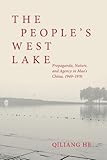The People’s West Lake : Propaganda, Nature, and Agency in Mao’s China, 1949–1976 / Qiliang He.
Material type: TextPublisher: Honolulu : University of Hawaii Press, [2023]Copyright date: ©2023Description: 1 online resource (216 p.) : 22 b&w illustrationsContent type:
TextPublisher: Honolulu : University of Hawaii Press, [2023]Copyright date: ©2023Description: 1 online resource (216 p.) : 22 b&w illustrationsContent type: - 9780824896904
- 324.251/0750904 23//eng/20230403eng
- DS797.88.W475 H4 2023
- online - DeGruyter
| Item type | Current library | Call number | URL | Status | Notes | Barcode | |
|---|---|---|---|---|---|---|---|
 eBook
eBook
|
Biblioteca "Angelicum" Pont. Univ. S.Tommaso d'Aquino Nuvola online | online - DeGruyter (Browse shelf(Opens below)) | Online access | Not for loan (Accesso limitato) | Accesso per gli utenti autorizzati / Access for authorized users | (dgr)9780824896904 |
Frontmatter -- Contents -- Preface -- Introduction -- Chapter One. Water, Labor, and Microbes -- Chapter Two. “Watching Fish at the Flower Harbor” -- Chapter Three. Forests, Propaganda, and Agency -- Chapter Four. Socialist Pigs -- Chapter Five. “Ghosts as Neighbors” -- Conclusion -- Abbreviations -- Notes -- Bibliography -- Index
restricted access online access with authorization star
http://purl.org/coar/access_right/c_16ec
The People’s West Lake examines the Chinese Communist Party’s (CCP) efforts to reconfigure Hangzhou’s urban space, alter the natural environment in West Lake (Xihu), and refashion the city’s culture in post-1949 China. It pieces together five initiatives between the 1950s and the 1970s: the dredging of the lake, the construction of the public park of Watching Fish at the Flower Harbor (Huagang guanyu), the afforestation movement, the development of collectivized pig farming around West Lake, and the two campaigns to remove lakeside tombs. These projects were intended to generate visible and tangible results—a lake with a good depth, a scenic public garden, greener hills surrounding the lake, a growing swine population and rising productivity of fertilizer, and a tourist site cleansed of burial grounds—while also being readily subject to the Party’s propaganda. These initiatives were designed both to achieve economic, cultural, and ecological utilities and to forge and popularize a sense of socialist nationhood. The CCP’s endeavor to fundamentally transform the West Lake area also opened up possibilities for both human and nonhuman actors to variously benefit from, get along with, and undermine the political authorities’ planning. This book thus emphatically foregrounds and unifies the agency of both humans and nonhuman entities that are not necessarily tied to intentionality, bringing into question the legitimacy of the human/nonhuman binary. Author Qiliang He explores the agency of both humans and nonhumans (including water, microbes, aquatic plants, the park, pigs, trees, pests, and tombs) to affect, deflect, and undercut the CCP’s sociopolitical programs, thereby diminishing the efficacy of state propaganda. Highlighting the nonpurposive agency of both actors problematizes the long-held resistance-accommodation paradigm, which presumes the resisters’ a priori subjectivities independent of the socialist system, in studying the state-society relationship in the People’s Republic of China. Using a project-based approach, The People’s West Lake gives the nature-human relationship in Mao’s China (best known as Mao’s “war against nature”) historical and cultural specificities to reexamine the PRC regime’s central planning and the issues related to it.
Mode of access: Internet via World Wide Web.
In English.
Description based on online resource; title from PDF title page (publisher's Web site, viewed 02. Jun 2024)


